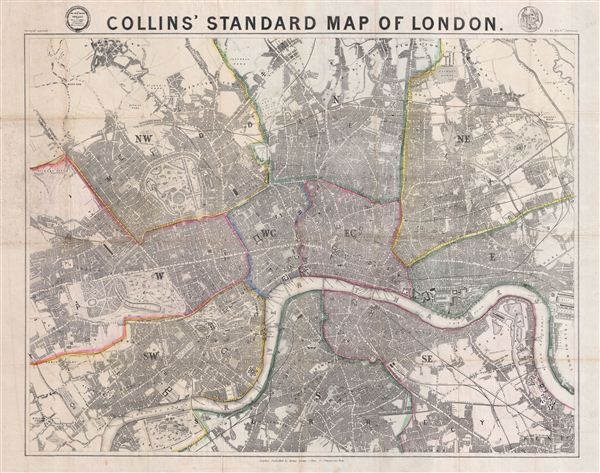Digital Image: 1858 Collins Pocket Map of London, England
London-collins-1856_d
Title
1856 (undated) 27 x 35 in (68.58 x 88.9 cm)
Description
FOR THE ORIGINAL ANTIQUE MAP, WITH HISTORICAL ANALYSIS, CLICK HERE.
Digital Map Information
Geographicus maintains an archive of high-resolution rare map scans. We scan our maps at 300 DPI or higher, with newer images being 600 DPI, (either TIFF or JPEG, depending on when the scan was done) which is most cases in suitable for enlargement and printing.
Delivery
Once you purchase our digital scan service, you will receive a download link via email - usually within seconds. Digital orders are delivered as ZIP files, an industry standard file compression protocol that any computer should be able to unpack. Some of our files are very large, and can take some time to download. Most files are saved into your computer's 'Downloads' folder. All delivery is electronic. No physical product is shipped.
Credit and Scope of Use
You can use your digial image any way you want! Our digital images are unrestricted by copyright and can be used, modified, and published freely. The textual description that accompanies the original antique map is not included in the sale of digital images and remains protected by copyright. That said, we put significant care and effort into scanning and editing these maps, and we’d appreciate a credit when possible. Should you wish to credit us, please use the following credit line:
Courtesy of Geographicus Rare Antique Maps (http://www.geographicus.com).
How Large Can I Print?
In general, at 300 DPI, you should at least be able to double the size of the actual image, more so with our 600 DPI images. So, if the original was 10 x 12 inches, you can print at 20 x 24 inches, without quality loss. If your display requirements can accommodate some loss in image quality, you can make it even larger. That being said, no quality of scan will allow you to blow up at 10 x 12 inch map to wall size without significant quality loss. For more information, it is best consult a printer or reprographics specialist.
Refunds
If the high resolution image you ordered is unavailable, we will fully refund your purchase. Otherwise, digital images scans are a service, not a tangible product, and cannot be returned or refunded once the download link is used.
Cartographer
Henry George Collins (January 17, 1808 - c. 1871) was a British engraver, bookseller, and map publisher active in London from about 1832 to 1858. Collins started his career as a bookbinder but was ultimately unsuccessful in this field declaring bankruptcy in 1839. Later Collins worked as a stationer for William and Henry Rock who subsequently pressed charges against him for embezzlement - for which he was found guilty and served four months in prison. After being released Collins embraced a future in map publishing and established an office among London's printers at 22 Paternoster Row. He partnered with Anthony la Riviere (lithographer) and John Kelly (colorist) and began producing atlases, globes, and pocket maps, most of which focused on the London area. Despite producing fine maps, Collins was a poor businessman and sales were slow. This possibly explains the medallion appearing on many of his maps c. 1854 onward, where he claims to have received the "Only medal awarded to England in the New York Exhibition or Maps, Atlases, and Globes". This is a highly unlikely claim for which we can find no substantiation and was most likely a fiction intended to appeal to the American tourist market in London. Apparently it didn't work, for in 1857 he again declared bankruptcy, signing over most of his assets to George Chater and Ephraim Brain. Most of his map plates and printing stock were subsequently acquired by George Stanford who succeeded where Collins failed, publishing numerous editions of many of Collins' fine maps. Some of Collins' maps were also republished by his sons, under the imprint "Collins Brothers", but by 1859 this firm too had failed. The last known reference to Collins in 1871, where he referred to himself as a "retired publisher". He must have died shortly afterwards. (Worms, L. and Baynton-William, A., British Map Engravers, (London) 2011, p. 156 - 157). More by this mapmaker...

